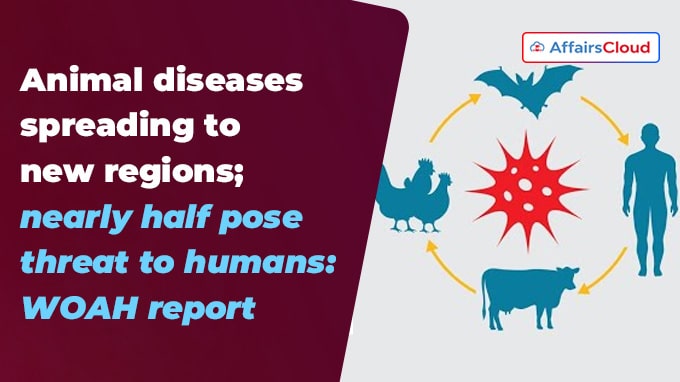 On May 23, 2025, Paris (France)-based World Organisation for Animal Health (WOAH), the international authority on animal health, released its 1st State of the World’s Animal Health report.
On May 23, 2025, Paris (France)-based World Organisation for Animal Health (WOAH), the international authority on animal health, released its 1st State of the World’s Animal Health report.
- The report highlighted that infectious animal diseases are spreading to new regions and species which were previously unaffected by them, with nearly half i.e. 47% of them have potential of zoonotic transmission (animal-to-human) or spreading between animals.
- The report was released ahead of 92nd session of WOAH which is scheduled to be held from May 25 to 29, 2025 in Paris, France.
About State of the World’s Animal Health Report:
i.The report marks the launch of WOAH’s flagship annual publication, which will be published annually on the occasion of WOAH’s general session.
ii.It provides the comprehensive review of animal disease trends, risks and challenges and their impact on human health, food security and economies.
iii.It highlights the positive impact of vaccination on high-priority animal diseases and the challenges associated with vaccine uptake and availability.
Key Findings:
The data of the report showed that major outbreaks were recorded across several regions in 2024 and early 2025, mainly driven by climate change, expanding international trade, and evolving pathogen dynamics.
i.Zoonotic Potential: The report revealed that 47% of WOAH-notified diseases between 2005 and 2023 were zoonotic in nature, which means capable of infecting humans.
ii.Avian Influenza Outbreaks: In 2024, there were 1,022 outbreaks of avian influenza (bird flu) or Highly Pathogenic Avian Influenza (HPAI) were reported in mammals across 55 countries, which was more than double the 459 outbreaks reported in 2023.
iii.Impact on Poultry: Over the last 20 years, bird flu has caused the loss or culling of over 630 million birds, causing substantial economic damage and disruptions in the global food supply.
iv.Antimicrobial Use: The use of anti-microbials, including antibiotics in animals decreased by 5% between 2020 and 2022, with Europe witnessing the sharpest decline of 23%, followed by Africa at 20%.
- Despite this, one in five countries is still using anti-microbials as promoters, which is discouraged by WOAH.
v.Antimicrobial Resistance (AMR): The report has projected that AMR is expected to cause livestock losses that will affect the food security of 2 billion people by 2050 and will result in a USD 100 trillion economic loss.
Countries Showed Success in Vaccination:
i.France became the 1st European Union (EU) country to implement nationwide vaccination campaign against bird flu in ducks, in October 2023.
ii.Türkiye developed a new vaccine for an outbreak of FMD within just 37 days and has vaccinated 14.2 million cattle (90% of the national herd) and 2.5 million sheep within 6 months.
iii.The Philippines with the support of WOAH vaccine bank, has now vaccinated millions of dogs against rabies.
Prevalence of other Major Diseases:
i.Foot and Mouth Disease (FMD): A total of 216 outbreaks of FMD were reported across 18 countries, including 29 exceptional epidemiological events. Germany saw its 1st FMD outbreak since 1988 and EU’s 1st since 2011.
ii.Peste des Petits Ruminants (PPR): Once confined to the global south has now re-emerged in Europe, with outbreaks in Greece, Romania, and Bulgaria in 2024 and in Hungary in January 2025.
iii.Lumpy Skin Disease (LSD): A total of 319 outbreaks of LSD were reported across 11 countries, including 11 exceptional epidemiological events.
- For the 1st time, LSD was detected in northern Africa, with outbreaks reported in Algeria, Libya, Tunisia and Japan. It has also re-emerged in Eastern and Southern Asia.
iv.African Swine Fever (ASF): In 2024, the disease spread across 1,800 kilometer (km) to Sri Lanka, affecting 16 countries and resulting in 6,807 recorded outbreaks.




